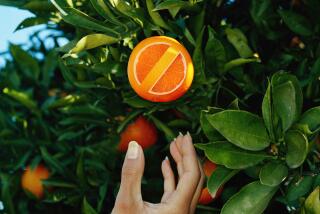Gardening : Being Fruitful With Plums and Peaches
- Share via
I got lucky when I planted a plum that stops, just as the peach begins. But that is one thing you should try to learn about fruit trees--how to keep them from overlapping and burying you in fruit.
The plum I planted is a Santa Rosa, with a deep, purplish-red skin covered with a blue “bloom,” the proper name for the dusty covering that children want to wipe off. The interior is yellow, shaded to red. The fruit are tart when my wife picks them, sweet when I find them on the ground.
This past week, I had just put the last plums in the bucket set aside for rotten fruit when the first peach fell off--perfect timing, though a week off in between would have been fine too.
The peach I planted is called Red Baron. I first tried it when I lived right over the beach in Pacific Palisades, where peaches are not a sure thing. It produced admirably there and threatens to overwhelm me where I now live, about 15 miles further inland.
This year, it is producing a large but manageable crop because most of the flowers were knocked off by a late rain. Usually I have to thin it considerably. The fruit is yellow inside and out, with a red blush. The fruit are rather large this time around, sweet and extremely juicy. You have to lean way over when eating them or make a mess.
I eat the peaches fresh off the tree because they bruise so easily. But I will stoop to eat one off the ground, if I see it fall. Growing up in apricot and prune orchards, I learned that fruit on the ground is always sweeter. That was convenient to know then because I couldn’t reach the fruit in the trees overhead.
If your tree produced too much fruit, make a note to thin it next year. If it didn’t produce any, it could have been the weather, or it may be the wrong variety for your area.
If your fruit trees already have produced, or have yet to, know that the times of ripening vary, from year to year and from locale to locale. But an “early” peach always precedes a “mid-season” or “late” variety, so if you look up the harvest season in a good reference work, you can figure how to keep all your trees from bearing at once, burying you in fruit. You can also learn which trees are recommended for your area.
My favorite reference is published by H. P. Books, a line sold at nurseries. It is “Western Fruit, Berries and Nuts,” subtitled “How to Select, Grow and Enjoy” by Robert L. Stebbins and Lance Walheim. It is the most up-to-date work and recognizes that only certain varieties of fruit trees will grow in our mild climate, which does not get enough cold for some of the most common varieties. It doesn’t include “Red Baron,” however, which I would call a mid-season peach, admirably suited to Southern California, which is where it was bred by Armstrong Nurseries, now Bear Creek Gardens.
Another way to figure how to avoid having everything ripen at once, and learn what trees do best where you live, would be to ask neighbors what varieties they grow and when they ripen. In fact, you could even graft a pruning from a neighbor’s tree onto one of your own.
My grandfather had one tree with five favorite varieties grafted onto it so something was always ripening throughout summer. This is not the time of year to do this (wait until winter) but it is a good time to sample the neighbor’s crops to see if they meet with your approval, and to check a book out of the library on the subject of grafting--an easy and useful art.
I have my eye on a particularly good apricot down the street that bears regular crops of small but very sweet fruit. In my part of town, apricots are not sure producers and, at best, tend to be alternate bearers, doing great one year but not the next. My neighbor’s ancient and unknown variety is the exception.
Though most of the books suggest pruning deciduous fruit trees such as peaches and plums in winter, this is also a good time, if you want to keep a tree in control.
Notice that as the tree is ripening fruit, or right after, it does most of its growing. That, and all the fruit, is why trees droop so at this time of the year and often need to be propped up. My peach has several such props under precarious branches.
(To make a sturdy prop, nail a pair of 2-by-6-inch pieces of three-quarter-inch plywood on either side of a 2-by-2 or 2-by-6 piece of lumber, making a notch for the branch to rest it.)
If you cut the new growth after it has grown a few inches, you will force the tree to branch. That will keep it smaller but will not effect fruiting.
Jack Christensen, who developed many of the fruit trees for Armstrong Nurseries, managed to keep all of his fruit trees at about 8 feet by conscientiously pinching back new growth as it emerged; wait until after the fruit is harvested to prune or it may sunburn.
He did most of his pruning in summer and he kept the trees small enough to fit an entire orchard in one corner of the front yard.






